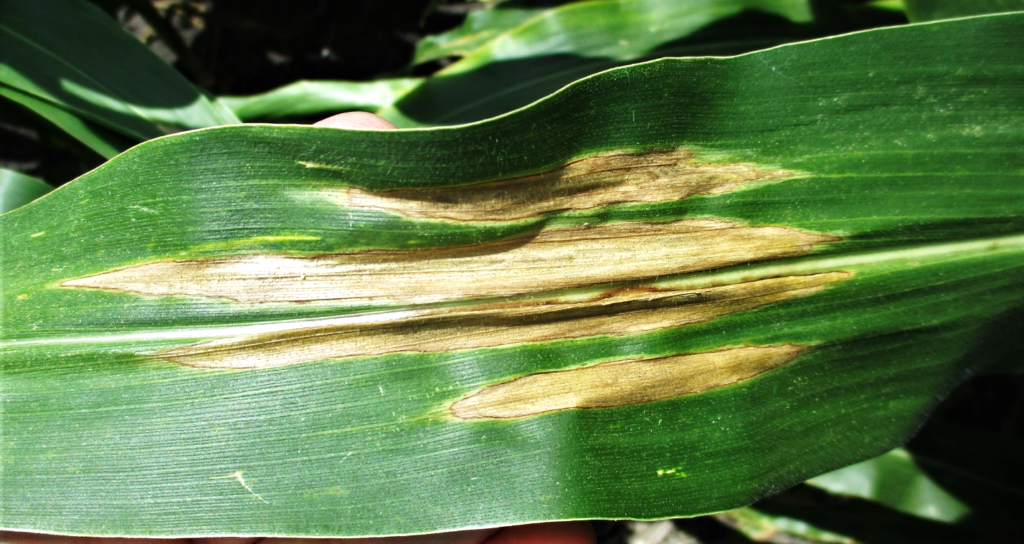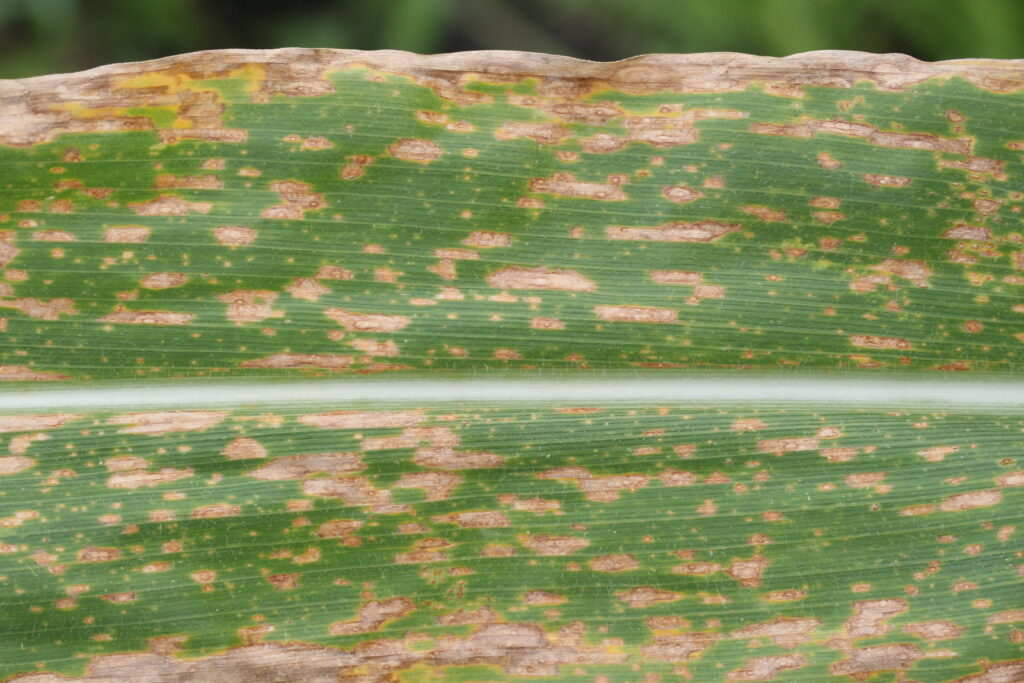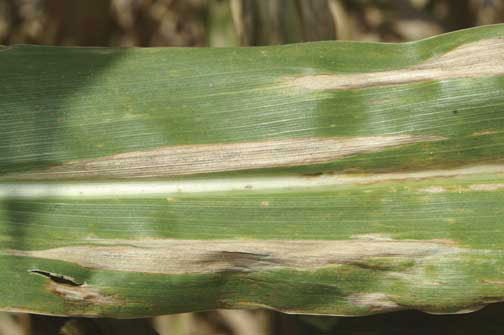Turcicum leaf blight is a severe disease that affects maize plants. It’s caused by a fungus called Setosphaeria turcica, and it’s a big problem for maize farmers all around the world. This disease can really hurt the amount of maize you can harvest.
Turcicum leaf blight is more common when the weather is warm and wet, with temperatures between 20 and 28 degrees Celsius. During an outbreak, it can cause small, cigar-shaped spots on the leaves of the maize plant. In some cases, it can completely destroy all the leaves.
There are different ways to try to manage this disease, but one of the best ways is to find maize plants that can resist it. However, this kind of resistance isn’t always reliable because the fungus can change and overcome the resistance. So, scientists are working on developing maize plants that can resist Turcicum leaf blight for a long time.
They’re using modern tools and lots of data to help them do this faster. One day, we might have maize plants that are very good at fighting off this disease. This article is all about what we know right now about Turcicum leaf blight and what we still need to learn.
Let’s also take a look at what the fungus looks like:
The fungus has brownish mycelium that looks like tiny threads.
It also has simple, tube-shaped structures called conidiophores, which are brown and have sections.
The spores it produces, called conidia, are olive grey and look like long spindles. They can be curved and have one to nine sections.
Turcicum leaf blight likes it when the weather is cool and wet, which is usually later in the growing season.
Turcicum Leaf Blight of Maize Symptoms:

- Long Cigar-Shaped Lesions: On the lower leaves of susceptible maize plants, you can see long lesions that look like cigars. These lesions can vary in color from grey-green to tan.
- Size Variation: These tan lesions are slender and oblong, and they can range in size from 1 to 6 inches.
- Parallel to Leaf Margins: The lesions typically run parallel to the edges of the leaves, and as the disease progresses, they can merge and cover the entire leaf.
- Underside Spore Production: Underneath the lesions, the fungus produces spores. These spores can give the affected area a dusty black or greenish appearance.
- Greyish-Green and Brittle Leaves: As the disease continues to advance, the leaves affected by Turcicum Leaf Blight turn greyish-green and become brittle. This makes them look similar to leaves that have been damaged by frost.
- Initial Light Spots: Before the cigar-shaped lesions fully form, you might notice small, light-green to grayish spots on the leaves. These spots typically appear about 1-2 weeks after the plant gets infected.
- Carbohydrate Reduction: The widespread damage caused by the lesions can severely impact the plant’s ability to produce carbohydrates, which are essential for grain filling. This can result in significant yield loss for farmers.
Also Read: Downy Mildew of Maize: Symptoms, Life Cycle, Management
Survival and Disease Cycle of Turcicum Leaf Blight (TLB):

Survival on Infected Plant Debris:
- The fungus that causes TLB can survive on leftover bits of infected maize plants.
Windblown Spore Spread:
- Spores from the fungus can be carried by the wind, spreading the disease to healthy maize plants.
Formation of Thick-Walled Spores:
- Conidia, which are spores produced by the fungus, can change into tough, thick-walled resting spores known as chlamydospores.
The TLB fungus stays alive during the winter as mycelia and conidia on maize leftovers on the soil surface. Sometimes, conidia turn into chlamydospores. When it gets warm and moist in early summer, new conidia grow on the old maize bits and are transported by the wind or rain to the lower leaves of young maize plants.
For the disease to take hold, several conditions are needed:
- Heavy dew.
- Frequent rainfall.
- High humidity.
- Moderate temperatures.
Infection by germinating conidia happens when there’s free water on the leaf surface for 6-18 hours, and the temperature is between 66 and 80°F (18-27°C). When everything aligns, lesions form, and a new batch of spores is produced, causing more damage to the plants.
If the TLB is severe and established before the maize plants start producing grain, it can divert sugars away from the stalks, leading to the plants bending or lodging. This is especially concerning when maize is harvested by machines. In dry conditions, TLB isn’t usually a big problem for maize. However, in some cases, it can lead to significant yield losses, ranging from 15 to 30%, and in extreme situations, losses as high as 70% have been recorded due to TLB.
Turcicum Leaf Blight of Maize Management
Preventing Method:
Izumonas-Best Fungicide
Contents: Pseudomonas Fluorescens
IZUMONAS is a biological product consisting of plant growth-promoting rhizobacteria (PGPR), which are naturally occurring bacteria found widely in nature. This unique product is designed to enhance plant defence mechanisms and promote healthy growth. IZUMONAS can be used on all types of crops without leaving any residue on the plants.
Izumil-Best Fungicide
Contents:
- Extract of Streptomyces griseus: 30%
- Extract of Streptomyces violaceus: 40%
- Dissolving agents: 30%
IZUMIL is a remarkable biotech research product that has been developed to activate the natural defence mechanism of plants. By using IZUMIL, plants can better protect themselves against fungal pathogens, improve their physiological functions, and develop resistance against various harmful microorganisms. Similar to IZUMONAS, IZUMIL can be safely used on all crops without leaving any residue.
Modes of Use:
- Seed Treatment: Mix 5-10 ml of IZUMONAS and IZUMIL per kilogram of seeds in an adequate amount of water. Submerge the seeds in this solution and allow them to dry in a shaded area before sowing.
- Seedling Treatment: Combine 100 ml of IZUMONAS and IZUMIL per 20 litres of water. Dip the roots of the seedlings in this solution for approximately 30 minutes prior to transplanting.
- Soil Application: Mix 500 ml of IZUMONAS and IZUMIL with 30 kilograms of farmyard manure (FYM) or soil. Apply this mixture to one acre of land before ploughing or irrigation.
- Foliar Application: Dilute 2-3 ml of IZUMONAS and IZUMIL each in 1 litre of water. Use this solution to spray the entire foliage of the plants, ensuring complete coverage on both sides of the leaves. It is advisable to shake the bottle before use. For best results, spray early in the morning or evening. If a power sprayer is used, double the recommended dosage.
Cultural Method:
- Nutrient Management: Ensure maize plants receive the right nutrients while growing. Avoid excessive nitrogen application.
- Residue Management: After harvesting, gather any infected crop residues. You can either burn them or bury them using deep tillage.
- Crop Rotation: Implement crop rotations like maize-potato, maize-upland rice, maize-soybeans, and maize-vegetables.

